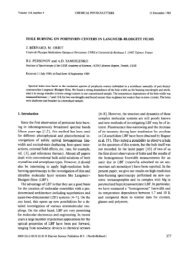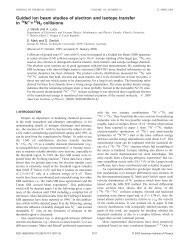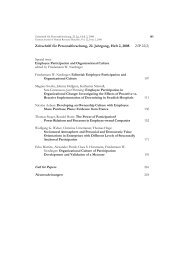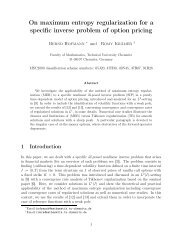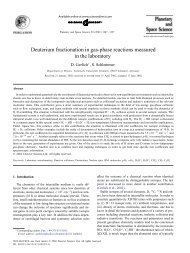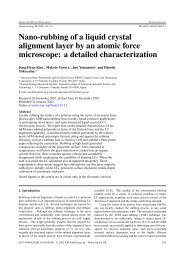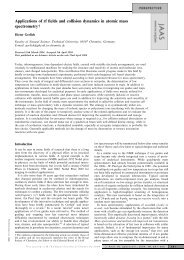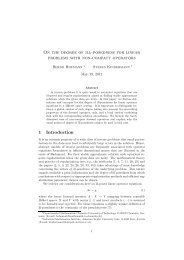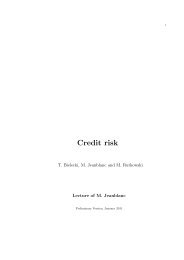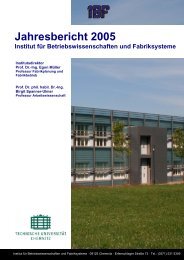1322 THe<strong>in</strong><strong>an</strong>dBH<strong>of</strong>m<strong>an</strong>n Lemma 2.1. Let <strong>the</strong> parameters X > 0, K > 0 <strong>an</strong>d r � 0 be fixed. Then <strong>the</strong> nonnegative function UBS(X, K, r,τ,s) is cont<strong>in</strong>uous for (τ, s) ∈ [0, ∞) × [0, ∞). Moreover, for (τ, s) ∈ [0, ∞) × (0, ∞),this function is cont<strong>in</strong>uously differentiable with respect to τ,where we have ∂UBS(X, K, r,τ,s) = rKe ∂τ −rτ �(d2) � 0, <strong>an</strong>d twice cont<strong>in</strong>uously differentiable with respect to s, where we have with ν := ln( (5) X K ) ∂UBS(X, K, r,τ,s) = � ∂s ′ (d1)X 1 2 √ s X = 2 √ 2πs exp � [ν + rτ]2 [ν + rτ] − − − 2s 2 s � > 0 8 (6) <strong>an</strong>d ∂2UBS(X, K, r,τ,s) ∂s 2 =−� ′ (d1)X 1 4 √ � [ν + rτ]2 − s s2 + 1 � 1 + 4 s =− X 4 √ � [ν + rτ]2 − 2πs s2 + 1 � � 1 [ν + rτ]2 [ν + rτ] + exp − − − 4 s 2s 2 s � . 8 (7) Fur<strong>the</strong>rmore, we f<strong>in</strong>d <strong>the</strong> limit conditions � ∂UBS(X, K, r,τ,s) ∞ lim = s→0 ∂s 0 −rτ (X = K e ) (X �= K e−rτ <strong>an</strong>d ) (8) lim s→∞ UBS(X, K, r,τ,s) = X. <strong>On</strong> <strong>the</strong> o<strong>the</strong>r h<strong>an</strong>d, <strong>the</strong> partial derivative (9) ∂UBS(X, K, r,τ,s) =−e ∂ K −rτ �(d2) 0forall(τ, s) ∈ [0, T ]×(0, ∞) ∂s <strong>an</strong>d hence <strong>the</strong> follow<strong>in</strong>g lemma. Lemma 2.2. The Nemytskii operator N def<strong>in</strong>ed by formulae (11) <strong>an</strong>d (12) is <strong>in</strong>jective on its doma<strong>in</strong> D+. In general (see, e.g., [1, p 15]), a Nemytskii operator N : v(t) ↦→ k(t,v(t)) applied to real-valued scalar functions v(t) is def<strong>in</strong>ed by a kernel function k(t, s), wheret varies <strong>in</strong> a f<strong>in</strong>ite <strong>in</strong>terval I ⊂ R <strong>an</strong>d s varies <strong>in</strong> R. If s ↦→ k(t, s) is cont<strong>in</strong>uous for almost every t ∈ I <strong>an</strong>d t ↦→ k(t, s) is measurable for all s ∈ R, <strong>the</strong> Nemytskii operator satisfies <strong>the</strong> Carathéodory condition. If<strong>the</strong>Nemytskii operator moreover satisfies a growth
<strong>On</strong> <strong>the</strong> <strong>nature</strong> <strong>of</strong> <strong>ill</strong>-<strong>posedness</strong> <strong>of</strong> <strong>an</strong> <strong><strong>in</strong>verse</strong> <strong>problem</strong> <strong>aris<strong>in</strong>g</strong> <strong>in</strong> <strong>option</strong> pric<strong>in</strong>g 1323 condition |k(t, s)| � c1 + c2|s| p/q with positive const<strong>an</strong>ts c1 <strong>an</strong>d c2,<strong>the</strong>n it maps cont<strong>in</strong>uously from L p (I) to Lq (I) for 1 � p, q < ∞ (see, e,g, [1, <strong>the</strong>orem 2.2]). In <strong>the</strong> context <strong>of</strong> formula (11) we set I := [0, T ]<strong>an</strong>d k(t, s) := UBS(X, K, r, t, s) (s�0), k(t, s) := UBS(X, K, r, t, 0) (s < 0). From lemma 2.1 it follows that <strong>the</strong> function UBS(X, K, r, t, s) generat<strong>in</strong>g <strong>the</strong> Nemytskii operator N is cont<strong>in</strong>uous <strong>an</strong>d uniformly bounded with |UBS(X, K, r, t, s)| < X due to <strong>the</strong> formulae (6) <strong>an</strong>d (9) for all (t, s) ∈ [0, T ] × [0, ∞). Then<strong>the</strong> Carathéodory condition <strong>an</strong>d a growth condition are satisfied <strong>an</strong>d we have cont<strong>in</strong>uity <strong>of</strong> N between spaces <strong>of</strong> power-<strong>in</strong>tegrable functions on <strong>the</strong> <strong>in</strong>terval [0, T ]as<strong>the</strong>follow<strong>in</strong>g lemma asserts. Lemma 2.3. The Nemytskii operator N def<strong>in</strong>ed by formula (11) with doma<strong>in</strong> D+ ∩ L p (0, T ) maps cont<strong>in</strong>uously from L p (0, T ) to L q (0, T ) for all 1 � p, q < ∞. As obvious throughout this paper we denote by L p (a, b) (1 � p < ∞) <strong>the</strong> B<strong>an</strong>ach space <strong>of</strong> p-power <strong>in</strong>tegrable real functions x(t) (a � t � b) with <strong>the</strong> norm �x�L p (a,b) := ( � b a |x(t)|p dt) 1/p ,byL∞ (a, b) <strong>the</strong> B<strong>an</strong>ach space <strong>of</strong> essentially bounded real functions on <strong>the</strong> <strong>in</strong>terval (a, b) with <strong>the</strong> norm �x�L ∞ (a,b) := ess sup t∈(a,b) |x(t)| <strong>an</strong>d by C[a, b] <strong>the</strong> B<strong>an</strong>ach space <strong>of</strong> cont<strong>in</strong>uous real functions def<strong>in</strong>ed on [a, b] with <strong>the</strong> norm �x�C[a,b] := maxt∈[a,b] |x(t)|. If we restrict <strong>the</strong> doma<strong>in</strong> <strong>of</strong> N to <strong>the</strong> set D0 := {v ∈ C[0, T ]:v(0) = 0,v(t) � 0 (0 < t � T )}, <strong>the</strong>n because <strong>of</strong> lemma 2.1 we have N : D0 ⊂ C[0, T ] −→ D+ ∩ C[0, T ]. Us<strong>in</strong>g <strong>the</strong> substitutions w := � v t as well as �(t,w) := UBS(X, K, r, t,v) we derive for all t > 0<strong>an</strong>dw>0 0 < ∂�(t,w) ∂w = X √ t� ′ ( ¯d1) � X√ t √ 2π with X w2 ln( ¯d1 K ) + t(r + 2 := ) √ . tw Consequently, for functions v1,v2,w1,w2 ∈ D0 with vi(t) = tw2 i (t) (i = 1, 2) <strong>the</strong>re are po<strong>in</strong>twise estimations � � � |[N(v1)](t) − [N(v2)](t)| � � ∂�(t,wt) � � 1 � � � ∂w �√ � t � v1(t) − � � � v2(t) � (0 < t � T ) with <strong>an</strong> <strong>in</strong>termediate value wt between w1(t) <strong>an</strong>d w2(t) <strong>an</strong>d |[N(v1)](t) − [N(v2)](t)| � X � � √ � 2π � v1(t) − � � � v2(t) � (0 � t � T ). (13) From (13) we directly obta<strong>in</strong> <strong>the</strong> follow<strong>in</strong>g. Lemma 2.4. The Nemytskii operator N def<strong>in</strong>ed by formula (11) with doma<strong>in</strong> D0 maps cont<strong>in</strong>uously from C[0, T ] to C[0, T ]. If we denote by B1, B2 <strong>an</strong>d B3 B<strong>an</strong>ach spaces <strong>of</strong> functions def<strong>in</strong>ed on <strong>the</strong> <strong>in</strong>terval [0, T ], <strong>the</strong>n we c<strong>an</strong> write <strong>the</strong> IP as a nonl<strong>in</strong>ear operator equation F(a) = u (a ∈ D(F) ⊂ B1, u ∈ D+ ∩ B2), (14)




